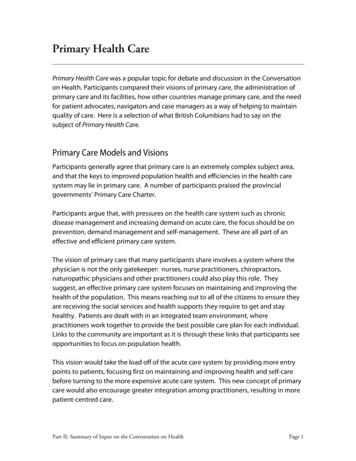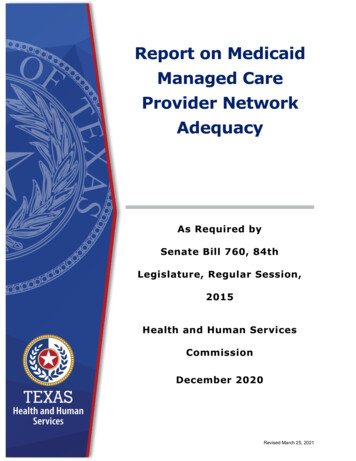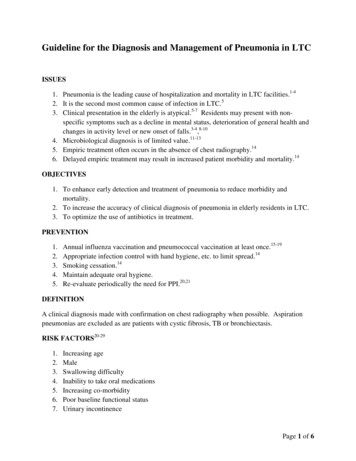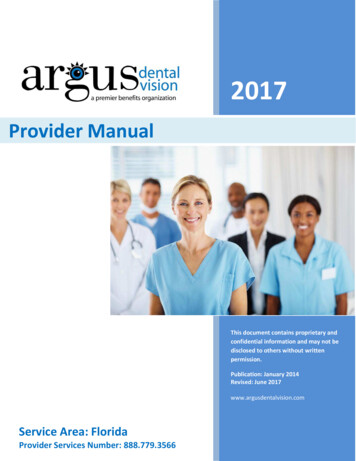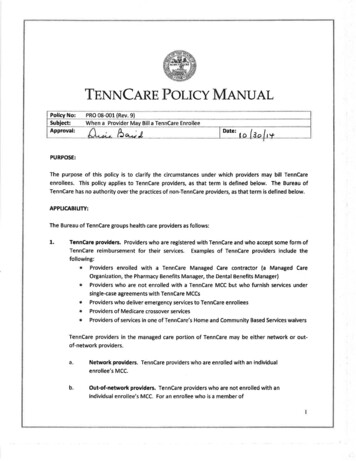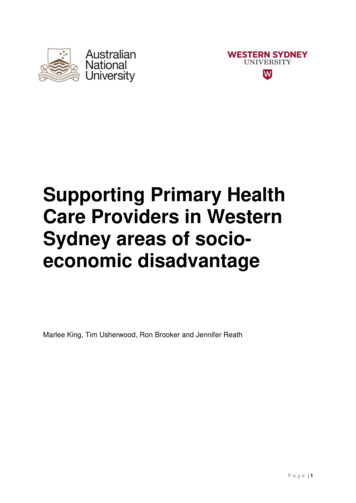
Transcription
Supporting Primary HealthCare Providers in WesternSydney areas of socioeconomic disadvantageMarlee King, Tim Usherwood, Ron Brooker and Jennifer ReathP a g e 1
ACKNOWLEDGEMENTSThis research is a project of the Australian Primary Health Care Research Institute, which is supported by a grant from theAustralian Government Department of Health. The information and opinions contained in it do not necessarily reflect the viewsor policy of the Australian Primary Health Care Research Institute or the Australian Government Department of Health.The research team acknowledges the key input of the following people and organisations: Went West Limited which providedassistance and input throughout the research; and the project reference group, Walter Kmet, Marina Fulcher, Di O’Halloranand Ian Corless (WentWest), Hani Bittar, Malcolm Ireland, Thava Seelan and Michael Burke (General Practitioners), LisaDawes (Practice Nurse) , Diana Aspinall (Consumer).CITATIONKing, Marlee; Usherwood, Tim; Brooker, Ron and Reath, Jennifer. Supporting primaryHealth care providers in Western Sydney areas of socio-economic disadvantage. Canberra:Australian Primary Health Care Research Institute, 2016.ISBN: 978-0-646-96082-1Western Sydney UniversityLocked Bag 1797Penrith NSW 2751 AustraliaT 61 4 1258 6135E medicine/som/disciplines/general practiceP a g e 2
ContentsBackground .6GPs AT THE DEEP END .6THE WESTERN SYDNEY CONTEXT .6RESEARCH AIMS AND OBJECTIVES .7Methods .8LITERATURE REVIEW .8QUALITATIVE ANALYSIS .8Results .9LITERATURE REVIEW .9The Importance of Primary Health Care .9Socio-economic disadvantage and health outcomes .9Supporting SE disadvantaged patients and barriers for Primary Health Care Providers. 10Supporting primary health care providers: Current initiatives and recommendations . 12Conclusion . 13ANALYSIS OF INTERVIEW DATA . 14Primary Health Care Provider perceptions of the Western Sydney patient population . 14High values, hard work: PHCP’s attitudes towards their work . 15The structure of general practice . 16Health systems issues . 17Discussion. 21OVERVIEW OF RESEARCH AIMS AND FINDINGS . 21THE WESTERN SYDNEY COMMUNITIES . 21HEALTH CARE PROVIDERS AND SERVICES . 22HEALTH SYSTEMS . 23LIMITATIONS . 25Recommendations . 26STRATEGIES IN THE COMMUNITY . 26STRATEGIES AT GENERAL PRACTICE LEVEL. 26STRATEGIES AT HEALTH SYSTEMS LEVELS . 26Conclusions . 27FUTURE RESEARCH . 27References. 28Appendix – Analysis of Interview Data . 37PARTICIPANT AND PRACTICE INFORMATION . 37P a g e 3
Qualitative analysis of findings. 37Primary health care provider perceptions of the Western Sydney patient population . 38High values, hard work: PHCP’s attitudes towards their work . 39The structure of general practice . 43Health systems issues . 45P a g e 4
AcronymsAcronymDefinitionAHPAllied Health ProviderEDEmergency DepartmentGPGeneral PractitionerGWSGreater Western SydneyHCPHealth Care ProviderHRECHuman Research Ethics CommitteeHWAHealth Workforce AustraliaITInformation TechnologyLGALocal Government AreaNHSNational Health ServicesNSWNew South WalesOOPOut-of-PocketPCMHPatient Centred Medical HomePHCPrimary Health CarePHCPPrimary Health Care ProviderPNPractice NurseSESocio-economicSEIFASocio-Economic Indexes for AreasP a g e 5
BackgroundSocial disadvantage is strongly associated with health disadvantage (1-5). Not only dosocially disadvantaged patients experience more ill health but the General Practitioners(GPs) and other Primary Health Care Providers (PHCPs) working with sociallydisadvantaged populations also face challenges. Our research builds on findings of theScotland ‘GPs at the Deep End’ program (6), and explores the relevance of theirmethodology in an Australian context.GPs AT THE DEEP ENDThe UK-based Deep End project aims to support health care providers working in verydeprived areas to improve health outcomes and to narrow health inequalities (6). Theproject drew on first-hand accounts of GPs from 100 practices in the most deprived areas inScotland. Fifteen meetings were held in which the experiences and views of GPs weregathered. The topics selected by participants for discussion were a mixture of issuesparticular to deprived areas such as mental health and addiction, patient empowerment andsupport for providers, as well as issues relevant to all general practices such asrelationships with secondary care and other providers and infrastructure and premises. Themeetings highlighted the strengths of the general practice model, which emphasises theimportance of contact, coverage, continuity, coordination, flexibility, relationships, trust andleadership. Within the meetings, participants expressed frustration about the lack ofresourcing, support and the marginalisation of their practices within current National HealthService (NHS) arrangements. A strong theme that emerged was the problematic anddysfunctional nature of many external relationships, including those with non-practiceemployed staff and certified health specialists (7).The GPs at the Deep End project has had a significant impact on the Scottish NHS, as ithas enabled GPs to share their experiences and views for the first time, and to address thehealth problems of the most deprived areas in Scotland. Research findings have beendescribed in 15 reports and serialised in the British Journal of General Practice.Recommendations include: providing practices with additional time to address patients’problems; improving patient health through a series of visits; enabling practices servingsocio-economic disadvantaged populations to share their experiences and undertakedemonstration projects, for example to examine the impact of attached workers in generalpractice (in mental health, addictions and social work) as well as the impact of combininggroups of small practices with area-based services (6).Given the significant role the Deep End project has played in supporting PHCPs working inthe most disadvantaged areas of Scotland, a Deep End project adapted to the Australiancontext, may have the potential to increase support for PHCPs in disadvantaged areas ofWestern Sydney.THE WESTERN SYDNEY CONTEXTGreater Western Sydney (GWS) has a growing population comprising 1,923,698 residentsin 2011 (8). GWS includes 14 local government areas (LGAs): Auburn City, Bankstown City,Blacktown City, Blue Mountains City, the Camden Council area, Campbelltown City, FairfieldCity, Hawkesbury City, Holroyd City, Liverpool City, the City of Parramatta, Penrith City, theHills Shire and Wollondilly Shire. Our project focuses on general practices and primaryhealth care providers in the Blacktown LGA.Blacktown City LGA has the largest urban Aboriginal and Torres Strait Islander population inNew South Wales (NSW), making up 2.7% of the Western Sydney population (9). WesternSydney is often the first point of call for migrants entering Australia (10) and has some of thelargest population groups of non-English speakers. According to census data, 42 per cent ofthe population in the Blacktown LGA are born overseas and just over one third speak aP a g e 6
language other than English (11). The most common languages spoken are ArabicFilipino/Tagalog, Hindi, Punjabi and Samoan (12).The 2011 Index of Relative Socio-economic Disadvantage (SEIFA)1 indicates that GreaterWestern Sydney area is a mixture of social advantage and disadvantage, with some areasclassified as extremely disadvantaged (such as Blacktown South-West) and other areasclassified as affluent such as the Hills Shire (12). Despite this socio-economic (SE) diversity,Western Sydney is generally more disadvantaged compared to Metropolitan Sydney, withlower average household incomes and lower levels of education for persons aged 15 andabove. The unemployment rate for the Blacktown LGA (7.2%) is higher compared to GreaterSydney (5.7%) and NSW (5.9%) (13). Within the Blacktown LGA, the Mt Druitt precinct(Blacktown South-West) shows the highest levels of SE disadvantage and is ranked thesecond most disadvantaged statistical local area in Sydney (14).The health challenges and barriers described in the original Deep End project are nottherefore unique to the most deprived areas of Scotland. In fact, Western Sydney sharesmany of the same health challenges. The health of Western Sydney is generally poorcompared to Metropolitan Sydney (12). The Western Sydney population has a higherprevalence of health risk factors including smoking (in men), physical inactivity and obesity(15). Western Sydney residents have a higher prevalence of chronic diseases such as heartdisease, hypertension, asthma and Type 2 diabetes (16, 17). Data from the NationalDiabetes Services Scheme suggest that Mt Druitt, Westmead and Blacktown are among thefive geographical areas with the highest number of registered diabetes cases (18). Datafrom the National Mortality Database also indicates that cardio-vascular related mortalityrates in some western and south-western suburbs of Sydney are higher than northern andsouthern suburbs of Sydney, and exceed rates in regional areas of New South Wales suchas Maitland (19). Mental health is also an issue for the Blacktown region, with reportsindicating high death rates from self-harm and suicide (20).The strong similarities between disadvantaged areas in Scotland and Western Sydney,suggest that the success of the ‘GPs at the Deep End’ project could well be repeated in aWestern Sydney-based ‘GPs at the Deep End’ project, to the benefit of PHCPs working indisadvantaged areas of Western Sydney and with relevance in other such communities.RESEARCH AIMS AND OBJECTIVESPrimary health care providers in Western Sydney are addressing the health and healthcareproblems of severely disadvantaged communities. Although they have substantialknowledge and experience, there has been little documentation of their views to date.Accordingly, it is valuable to explore the first-hand accounts of GPs, GP registrars, PracticeNurses (PNs), practice staff and Allied Health Providers (AHPs) working in areas of SEdisadvantage. The specific aims of the ‘GPs at the Deep End: Western Sydney’ project areto:1. Report on the international evidence related to PHCPs working in areas of socialand health disadvantage including related support strategies2. Investigate views of PHCPs working in Western Sydney areas of social andhealth disadvantage regarding stresses experienced and support needs, and3. Develop a plan for strategies that would assist in meeting the needs of thesepractitioners.1The SEIFA index rating or Socio-Economic Indexes for Areas is used to represent the levels ofsocio-economic disadvantage. The index is derived from attributes that reflect disadvantage such aslow income, lack of education, high unemployment and jobs in relatively unskilled occupations.P a g e 7
MethodsWe used collected and synthesised data from the following sources,1. Review of the Australian and international literature, including the “grey”literature2. Qualitative data from face to face and telephone interviews.LITERATURE REVIEWWe reviewed academic databases including PsycINFO, PubMed, EBSCO, and MEDLINE,as well as Government websites including websites of the Australian Primary Health CareResearch Institute and the Australian Department of Health. We used keywords andphrases including “primary care”, “health care”, “family practice”, “general practice” “sociallydeprived” “deprivation” and “socio-economic disadvantage”. Australian and internationalliterature was included in the search, as well as “grey literature” such as government reports,theses/dissertations and research reports.QUALITATIVE ANALYSISWe received ethics approval from the Western Sydney University Human Research EthicsCommittee, HREC approval number H10989.Informed by the literature review and discussion with the Project Reference Group, wedeveloped a semi-structured interview schedule and a focus group interview schedule. TheProject Reference Group assisted in identifying interview participants including GPs,practice staff, AHPs and community members. Interview participants were initiallycontacted via email or telephone using the ethics approved participant informationstatement. Additional recruitment methods were employed, including snowballing participants informed team members and colleagues about the research project. Anotherrecruitment strategy involved identifying practices that met the research criteria andcontacting them, providing information regarding the research project.In order to recruit patients, potential participants were identified by GPs and theiradministrative staff provided the study information at reception. A standard script was usedto ensure that potential participants were given consistent information.Participants completed and signed an ethics-approved participant consent form prior tocommencing the interview and completed a brief demographic form. The interviews wereconducted by a member of the research team and were digitally recorded. Interviewrecordings were transcribed by an independent transcription service.We conducted a thematic analysis following the relevant guidelines (21, 22).During each stage of analysis, the method of analysis and the codes derived werediscussed with members of the research team and the Project Reference Group. Thisensured that there was a consistency within patterns identified, and that the analysis wasplausible. Data were categorised by creating codes using Nvivo2. The final stage involvedthe revision and refinement of themes, examining at the level of the codes to ensure acoherent pattern (21).2Nvivo is a qualitative data analysis computer software package. It has been designed for qualitativeresearchers working with very rich text-based or multimedia information, where deep levels ofanalysis on small or large volumes of data are required.P a g e 8
ResultsLITERATURE REVIEWThis literature review focuses on exploring impact of SE disadvantage on patient health,challenges experienced by PHCPs working in areas of disadvantage and strategies throughwhich PHCPs can be supported.The Importance of Primary Health CarePrimary health care is a critical element in the health care system – it is key to maintainingand improving a population’s health (23, 24). As well as the role of primary health care inpreventing illness and death, there is evidence that health care systems that are based onstrong or high performing primary health care are associated with improved healthoutcomes. There is concordance between strength of primary care and key health indicatorsincluding birth outcomes, life expectancy, and age-adjusted death rates (24-26). Theenhancement of primary health care, particularly general practice, is associated with lowerall-cause mortality, regardless of income inequality (26), suggesting that strong primary carecan buffer the negative health outcomes associated with SE disadvantage.Populations with higher primary care provider to patient ratios have lower hospital admissionrates for acute and chronic conditions (27), as well as improvement in low birth weight; lifeexpectancy; and self-rated health (28). Adequate provision of primary health care isassociated with lower costs and more cost effective health care (29).Socio-economic disadvantage and health outcomesPoor social and economic circumstances affect health throughout life (6, 30-32). Comparedto advantaged populations, patients from socially disadvantaged populations have differenthealth needs and priorities, and face challenges in management of their health (7, 33-35).Patient health outcomesPatients from SE disadvantaged communities have higher mortality and morbidity ratescompared to those from advantaged communities (3, 4, 36). Socioeconomic disadvantage islinked to a range of health problems, including low birthweight, cardiovascular disease,hypertension, arthritis, diabetes, and cancer (37). Patients living in the most disadvantagedareas report poorer self-assessed health and are more likely than their wealthiercounterparts to experience issues relating to mental health and disability (1, 32). As theSEIFA score of an area decreases, the prevalence of psychological distress increases,however the causal relationship is unclear (38).SE disadvantage is also associated with a higher prevalence of risk factors, such asenvironmental exposures, lack of social inclusion and cohesion, limited access to healthcare, chronic stress and poor health behaviours/choices (39). Research suggests thatchildren who experience SE disadvantage have a high risk of developing tobacco, alcohol,or drug dependence, as well as a poor cardiovascular risk profile entering young adulthood.Poor health outcomes in adulthood are, in part, due to disadvantaged children's high levelsof exposure to a combination of factors, including mental and physical health issues in thefamily and exposure to childhood maltreatment (40).Patient prioritiesPatients from lower SE groups not only have greater health needs compared to advantagedgroups but may have different priorities regarding primary health care (41-43). Studies showthat in general, patients prefer a GP who provides information, support and involves them intreatment decisions (44), and place high value on accessibility and availability of primaryhealth care (45, 46). However, research focusing on priorities of SE disadvantaged patientssuggests that when choosing a family practice, they have a greater focus on access (43).P a g e 9
While patients value medical skills, continuity appears to be a more important reason forattending their current practice (41). This may be related to the high prevalence of chronicdisease within disadvantaged populations and the need for continuity in these situations.A qualitative study of patients living in a highly disadvantaged area in Scotland reported thatpatients valued two key factors in relation to their GP experiences, competence andempathy or caring. Specifically, participants emphasised the importance of feeling listenedto by the doctor and feeling able to talk; being treated as an individual; feeling like the GPunderstood them as a whole; receiving explanations that can be understood. Similar to thefindings above however, factors such as continuity, access and time during consultationwere also described as essential (47). Such inconsistencies in research findings suggestthat further research is needed to further understand SE disadvantaged patients’preferences and values in the context of primary health care.Health care needs – The Inverse Care LawPatients from disadvantaged areas generally have greater health care needs thanadvantaged patients. Despite this, provision of health care is often poorer. Thisphenomenon, whereby those in most need are least likely to get the care required, has beenlabelled the ‘inverse care law’ (48, 49).Universal health care systems such as in Australia, are intended to provide equity in healthoutcomes across the social spectrum (50, 51). However, it is argued that universal healthcare “is not a one-off and irreversible achievement” (52) (p 244). Health care costs carriedby Australian patients have risen and are now higher than in most other high incomecountries. Gaps in government funded services (notably dental care) increasingly making itdifficult for SE disadvantaged patients and those with chronic and complex illness to accessneeded health care (42, 53). Such gaps in health care illustrate the inverse care law, aspatients in most need of health care, are least likely to be able to afford it and thus less likelyto seek it.When they do access care, lower SE patients are likely to receive lesser quality carecompared to those from higher SE groups (51). GPs have been shown to give patients fromdisadvantaged backgrounds less involvement in treatment decisions; more biomedical talk;less control over communication; less information, and more time spent on physicalexamination (54). Evidence suggests GPs spend less time with disadvantaged patients (55).This is concerning as a strong relationship between HCP and patient is linked, not only topatient satisfaction, but also improved health outcomes (56-58). Development of such arelationship is argued to centre on trust, empathy, information exchange, rapport and shareddecision making, requiring the HCP to engage in patient centred care (59-61). However SEdisadvantaged patients may not be receiving this type of care.Supporting SE disadvantaged patients and barriers for Primary Health Care ProvidersDifferences in quality of care provided to SE disadvantaged patients do not necessarilyreflect prejudice in relation to these patients. Some research suggests that some PHCPsmay intentionally change clinical management decisions based on their patient’s SE statusin the belief that this is in their patients’ interests (62). A GP may provide a SEdisadvantaged patient less aggressive diabetes management, postpone testing, or use thanideal or nonstandard treatments in order to provide care that is more affordable, feasible, orunderstandable to their patient. Further research also suggests that the discrepancy in caredemonstrates the ways in which PHCPs struggle to cope with the negative impact of SEdisadvantage (35).Patient related factorsPrimary health care providers working with disadvantaged populations address an increasedburden of ill health with limited resources and time (31, 62, 63). For many GPs, the constantstream of complex issues is an “ongoing struggle” (p 51), with professional and personalP a g e 10
consequences (35). Interviews with 15 GPs and 4 PNs in practices with a high percentageof SE disadvantaged patients, revealed many were overwhelmed and exhausted by theirattempts to assist patients in managing their chronic illness and multi-morbidity. One GPdescribed her ongoing struggle to “get one thing under control (then) something elsehappens” (p. 51). Participants also described aspects of their work as “demoralising”,“overwhelming” and “soul destroying” (p. 52). Such accounts emphasise the emotional tollfor GPs of working with SE disadvantaged patients with chronic illness and multi-morbidity.The high incidence of social problems in SE disadvantaged populations means that PHCPsoften attend needs beyond physical health. PHCPs often provide social support for patients,and assist them to navigate the complex health care system (31). These tasks increasePHCP workload as do patient factors including lower education and health literacy, distrustof specialised services, heightened expectations of GPs, cultural differences and difficultiesarticulating needs (55). These factors impact on communication and affect adherence (64).Higher prevalence of psychological distress amongst SE disadvantaged patients meansGPs often need to attend to this (65). GPs are required to move beyond a role of medicalpractitioner, with some describing themselves as taking the role of “friend” or “priest” (35).Time pressureThe addition of these extra duties to a busy schedule places pressure on PHCPs increasingtheir stress (66) and restricting their capacity to provide adequate support for patients (67,68). Simply gathering information about the illness, including symptoms and psychosocialcontext, can take significant time with complex physical and psychosocial issues (69). Suchtasks take longer in settings of language and cultural differences and lower health literacy.Given that patients with complex needs are likely to require longer visits, payment systemsbased exclusively on fee-for-service (FFS3), can be a major barrier for PHCPs wanting toprovide longer visits to such patients (31). Many countries use one, or a combination of thefollowing payment systems: salary4, capitation5 and fee-for-service (70). In Australia, GPsreceive most of their remuneration through FFS payments (71). GPs working indisadvantaged areas may be more likely to bulk bill and may therefore utilise multiple shortconsultations rather than fewer long ones, in order to maximise their income (55).BurnoutBurnout is an occupational stress reaction to demanding and emotionally charged work (72).Risk factors for burnout in PHCPs include workload, changes in systems, financial strain,challenges with work relationships and difficulties balancing professional and private life(73). Burnout is detrimental to PHCPs, leading to physical exhaustion (74), insomnia (75)and increased use of alcohol (76). It also impacts on patients, as burnout alters the quality ofcare provided and relationships with patients as HCPs coping with emotional exhaustionand burnout may distance themselves emotionally from their patients (76).The constant challenges and stresses encountered by PHCPs working with disadvantagedpatients, put them at risk of burnout. However not all such PHCPs experience burnout (34).Of 15 GPs working in disadvantaged urban communities, some reported experiencingburnout, however most thrived (34). These ‘thriving’ doctors, described three factors thatpromoted strength and resilience whilst working with marginalised groups - respect andappreciation for their patients, a sense of control over their practice, and being intellectuallyinterested in their work. Such findings suggest strategies that protect PHCPs from workassociated distress and burnout, enabling them to provide high quality care to their patients.3Fee-for-service (FFS): payment made to a PCP for every item of service or unit of care that theyprovide.4 Salary: regular payment to the PCP for a set number of working hours or sessions per week.5 Capitation: payment made to PHCP for each patient for whom care is provided rather than forepisodes of care.P a g e 11
Supporting primary health care providers: Current initiatives and recommendationsThe strategies above may assist PHCPs to avoid negative outcomes such as burnout,however their sustainability depends on how primary health care is supported andresourced. In the following section we described current programs and strategies thatsupport PHCPs. These are not specific to those working with disadvantaged communities,however may assist in combatting the challenges affecting these PHCPs.Managing time pressuresResearch suggests that lengthening consultation time or intervals between consultationsfacilitates patient centred care and patient enablement (63) and can reduce stress in PHCPs(66). Evidence also supports dealing with certain health issues in one single visit rather thanmultiple visits (77). Routinely allowing patient choice of appointment length increases patientempowerment, and improves doctor patient relationships and delivery of health promotion(78). The feasibility of these approaches needs further research.Group visits hav
Health care providers in Western Sydney areas of socio-economic disadvantage. Canberra: Australian Primary Health Care Research Institute, 2016. ISBN: 978-0-646-96082-1 Western Sydney University Locked Bag 1797 Penrith NSW 2751
